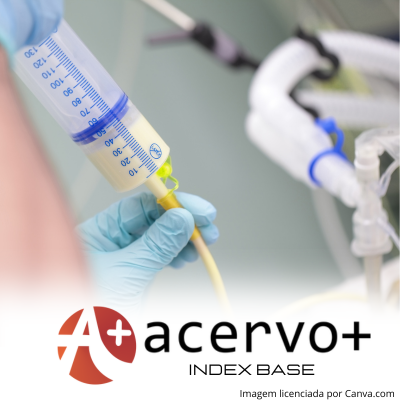Avaliação do alto risco nutricional pelo NUTRIC Score em pacientes críticos
##plugins.themes.bootstrap3.article.main##
Resumo
Objetivo: Avaliar a associação entre alto risco nutricional pelo mNUTRIC e mortalidade em Unidade de Terapia Intensiva (UTI). Métodos: Trata-se de um estudo transversal descritivo e analítico. Foram coletados dados do prontuário eletrônico e de um banco de dados informatizado. Foi utilizada a versão NUTRIC modificada, que desconsidera a variável interleucina-6 (IL-6) e participantes com Score superior a 5 pontos foram classificados como em alto risco nutricional. Foram inclusos 732 pacientes graves admitidos em UTI entre 2017 e 2021 e com tempo de internação hospitalar superior a 24h. Resultados: A Regressão de Cox demonstrou que pacientes classificados em baixo risco nutricional pelo mNUTRIC Score apresentaram em média 2,5 vezes maior sobrevida (RR = 2,509; p < 0,01; 95% CI = 2,011 – 3,129). A regressão logística revelou que pacientes em alto risco nutricional apresentam 6 vezes mais chances de evoluir a óbito durante a internação (HR = 5,986; p < 0,01; 95% CI = 4,329 – 8,277). Conclusão: Conclui-se que o alto risco nutricional pelo mNUTRIC Score prediz corretamente o risco de morte e outros desfechos desfavoráveis em pacientes críticos.
##plugins.themes.bootstrap3.article.details##
Copyright © | Todos os direitos reservados.
A revista detém os direitos autorais exclusivos de publicação deste artigo nos termos da lei 9610/98.
Reprodução parcial
É livre o uso de partes do texto, figuras e questionário do artigo, sendo obrigatória a citação dos autores e revista.
Reprodução total
É expressamente proibida, devendo ser autorizada pela revista.
Referências
2. AL-DORZI HM e ARABI YM. Nutrition support for critically ill patients. Journal of Parenteral and Enteral Nutrition, 2021; 45(S2): 47-59.
3. AL-DORZI HM, et al. Lower versus higher dose of enteral caloric intake in adult critically ill patients: a systematic review and meta-analysis. Critical Care, 2016; 20(1): 358.
4. ARABI YM, et al. The intensive care medicine research agenda in nutrition and metabolism. Intensive Care Medicine, 2017; 43(9): 1239-1256.
5. BRASCHER JM, et al. Use of the modified "Nutrition Risk in the critically ill" score and its association with the death of critically ill patients. Clinical Nutrition ESPEN, 2020; 35: 162-166.
6. CASTRO MG, et al. Diretriz brasileira de terapia nutricional no paciente grave. Braspen Journal, 2018; 33(1): 2-36.
7. CHOURDAKIS M, et al. Translation of the modified NUTRIC score and adaptation to the Greek ICU setting. Clinical Nutrition ESPEN, 2019; 29: 72-76.
8. CORREIA M, et al. Inquerito brasileiro de avaliaçäo nutricional hospitalar (IBRANUTRI): Metodologia do estudo multicêntrico. Revista Brasileira de Nutrição Clínica, 1998; 13(1): 30-40.
9. GONZALEZ MC, et al. Complementarity of NUTRIC score and Subjective Global Assessment for predicting 28-day mortality in critically ill patients. Clinical Nutrition, 2019; 38(6): 2846-2850.
10. HEYLAND DK, et al. Identifying critically ill patients who benefit the most from nutrition therapy: the development and initial validation of a novel risk assessment tool. Critical Care, 2011; 15(6): R268.
11. JAVID Z, et al. Nutritional adequacy in critically ill patients: Result of PNSI study. Clinical Nutrition, 2021; 40(2): 511-517.
12. JEONG DH, et al. Relationship between Nutrition Intake and 28-Day Mortality Using Modified NUTRIC Score in Patients with Sepsis. Nutrients, 2019; 11(8): 1906.
13. JUNG YT, et al. Association of Inadequate Caloric Supplementation with 30-Day Mortality in Critically Ill Postoperative Patients with High Modified NUTRIC Score. Nutrients, 2018; 10(11): 1589.
14. KONDRUP J, et al. ESPEN guidelines for nutrition screening 2002. Clinical Nutrition, 2003; 22(4): 415-21.
15. LEW CC, et al. Combining 2 Commonly Adopted Nutrition Instruments in the Critical Care Setting Is Superior to Administering Either One Alone. Journal of Parenteral and Enteral Nutrition, 2017; 42: 872-876.
16. LI G, et al. Nutritional risk and therapy for severe and critical COVID-19 patients: A multicenter retrospective observational study. Clinical Nutrition, 2021; 40(4): 2154-2161.
17. LIN PY, et al. Use of modified-NUTRIC score to assess nutritional risk in surgical intensive care unit. Journal of the Chinese Medical Association, 2021; 84(9): 860-864.
18. MARCHETTI J, et al. High nutritional risk is associated with unfavorable outcomes in patients admitted to an intensive care unit. Revista Brasileira de Terapia Intensiva, 2019; 31(3): 326-332.
19. MCCLAVE SA, et al. Guidelines for the Provision and Assessment of Nutrition Support Therapy in the Adult Critically Ill Patient: Society of Critical Care Medicine (SCCM) and American Society for Parenteral and Enteral Nutrition (A.S.P.E.N.). Journal of Parenteral and Enteral Nutrition, 2016; 40(2): 159-211.
20. MCWHIRTER JP e PENNINGTON CR. Incidence and recognition of malnutrition in hospital. BMJ, 1994; 308(6934): 945-8.
21. MUKHOPADHYAY A, et al. Association of modified NUTRIC score with 28-day mortality in critically ill patients. Clinical Nutrition, 2017; 36(4): 1143-1148.
22. PAZ LS e COUTO AV. Avaliação nutricional em pacientes críticos: revisão de literatura. Braspen Journal, 2016; 31(3): 269-77.
23. PUTHUCHEARY ZA, et al. Acute Skeletal Muscle Wasting in Critical Illness. JAMA, 2013; 310(15): 1591-1600.
24. RAHMAN A, et al. Identifying critically-ill patients who will benefit most from nutritional therapy: Further validation of the "modified NUTRIC" nutritional risk assessment tool. Clinical Nutrition, 2016; 35(1): 158-162.
25. REIS AM, et al. NUTRIC score use around the world: a systematic review. Revista Brasileira de Terapia Intensiva, 2019; 31(3): 379-385.
26. SINGER P, et al. ESPEN guideline on clinical nutrition in the intensive care unit. Clinical Nutrition, 2019; 38(1): 48-79.
27. SOUZA IA, et al. Performance of NUTRIC score to predict 28-day mortality in critically ill patients after replacing APACHE II with SAPS 3. PLOS ONE, 2022; 17(7): e0270455.
28. WANG N, et al. Association between the modified Nutrition Risk in Critically Ill (mNUTRIC) score and clinical outcomes in the intensive care unit: a secondary analysis of a large prospective observational study. BMC Anesthesiology, 2021; 21(1): 220.
29. WERNECK GL e CARVALHO MS. A pandemia de COVID-19 no Brasil: crônica de uma crise sanitária anunciada. Cadernos de Saúde Pública, 2020; 36(5): e00068820.
30. ZHOU HJ, et al. Nutritional status and prognostic factors for mortality in patients admitted to emergency department observation units: a national multi-center study in China. World Journal of Emergency Medicine, 2023; 14(1): 17-24.

